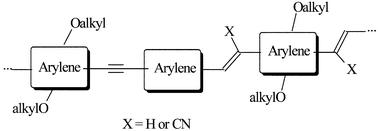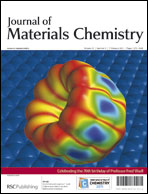Alkoxy-substituted poly(arylene-ethynylene)-alt-poly(arylene-vinylene)s: synthesis, electroluminescence and photovoltaic applications†
Abstract
Poly(arylene-ethynylene)-alt-poly(arylene-vinylene)s (PAE-PAVs) combine the intrinsic features of both poly(arylene-ethynylene) (PAE) and poly(arylene-vinylene) (PAV) in a single polymeric backbone. They exhibit enhanced electron affinity, as compared to parent poly(p-phenylene-vinylene) (PPV), making electron injection easier, placing them as potential candidates for low turn-on voltage organic light emitting diodes (OLEDs). Depending on the chemical structures, PAE-PAVs have been efficiently used either as donor materials in polymer-PCBM (phenyl-C61-butyric acid methylester) or polymer-Vinazene (

- This article is part of the themed collection: Celebrating the 70th birthday of Professor Fred Wudl

 Please wait while we load your content...
Please wait while we load your content...